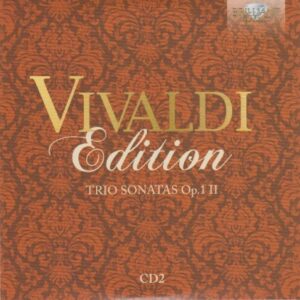 The second CD of the Brilliant Classics Vivaldi Edition seems fitting for today’s weather, which is gray and cold (38 degrees).
The second CD of the Brilliant Classics Vivaldi Edition seems fitting for today’s weather, which is gray and cold (38 degrees).
We’re back to typical March weather.
Thankfully, although CD 2 – which continues Vivaldi’s Trio Sonatas (Op. 1 II) – starts out in a dreary, kind of down-tempo fashion, it quickly picks up to what I’d expect to hear from Vivaldi, which helps elevate my mood considerably.
In fact, this music makes me smile, especially the little violin trills that sound so baroque. Makes me think of a cotillion on a TV series like Downton Abbey.
Yeah, I know Downton Abbey was not set in the 18th century. But, at times, when a formal ball was called for, this kind of music might be what’s played. The Jazz Age had barely arrived when the series ended – in the mid 1920s – after six seasons.
 My point is: Music like this always makes me think of a British movie or TV series set back a few centuries.
My point is: Music like this always makes me think of a British movie or TV series set back a few centuries.
To my ears, it sounds playfully stuffy. Like it was made to be heard by people wearing powdered wigs and flowing dresses or puffy shirts.
I wonder if music like this was ever considered what we’d today call “elevator music,” you know – that throwaway genre of music made to occupy one’s mind between floors of a building, or while sitting in a doctor’s office. In other words, was this music for people to sit and listen to, intently, perhaps even reverently? Or was this music composed like a Pop song today?
Just the Facts
CD 2 of the Vivaldi Edition clocks in at 43:38. It was recorded in Italy on March 12-16, 2012.
There’s scant information about these Trio Sonatas on Wikipedia. In fact in this entry I learned only a couple of new things:
Twelve Trio Sonatas, Op. 1 is the first collection of musics composed by Antonio Vivaldi, and published by the Venetian publisher Giuseppe Sala in 1705, the first edition is believed to have been published around 1703. These sonatas are for two violins and basso continuo. The last music is a same title of “La Follia” as Corelli’s Twelve Violin Sonatas, Op. 5.
According to the CD sleeve, they were composed in Venice in 1705, which would account for a Venetian publisher named Giuseppe Sala publishing them. My guess is they were composed between 1703 and 1705.
The liner notes in the box set consider of just a slim booklet, hardly fitting a composer of Vivaldi’s status. However, the good folks at Brilliant Classics have provided (on their web site) a download of a pdf of very extensive liner notes. You can obtain it here.
But even the 8-page booklet in the box set, written by Jos van der Zanden, is entertaining, from the opening paragraph:
Founder of the Baroque concerto, master violinist, innovative orchestrator, pioneer of programme music: the qualifications by which Antonia Vivaldi (1678-1741) secured his name in the history of Western music are comprehensive. It is no coincidence that the Italian master was admired by none other than J.S. Bach, who studied his works, embraced his musical style, and, out of sheer enthusiasm, even arranged some of his concertos. Reportedly, the ‘red priest’ (red hair seems to have been a family characteristic) was a rather difficult and unpleasant person to deal with; he as vain, stingy, and complacent. No one in the 18th century, however, disputed his extraordinary originality and imaginative powers.
That sets the stages perfectly!
I always wondered where the band Red Priest got it’s name.
My wife and I saw Red Priest here in Grand Rapids a decade and a half or so ago. I remember leaving the concert wanting to play the recorder as well as band leader Piers Adams did. Of course, that was a pipe dream. Few people on earth play the recorder that well. Still, the music and magic of seeing Red Priest started a years-long love for Vivaldi’s music.
Which brings me the present day.
This recording is marked DDD, which means it is an all-digital recording. (Digitally recorded, Digitally mixed, and Digitally mastered.) Purists, those folks who think vinyl sounds better than CDs (they’re wrong) would probably look askance at this recording. To my ears, this is the best way to record music to precisely capture every note. But what do I know?
Just the Feelings
Recording quality: 5
Overall musicianship/vocals: 5
CD liner notes: 2 (booklet in box set)/5 pdf download from web site
How does this make me feel: 4
An excellent recording of an excellent performance!
Once again, as I listened to this on repeat, a track or two stuck out – one in particular.
This time, it was Track 20, movement III (allegro) of Sonata 11 in B minor RV79. That gripped me immediately, so much so that I noted it on a pad of paper beside me.
I’m enjoying my time with Antonio Vivaldi. He may have been a colossal weenie back in 1700. But his music is a lot of fun to listen to in 2024.
